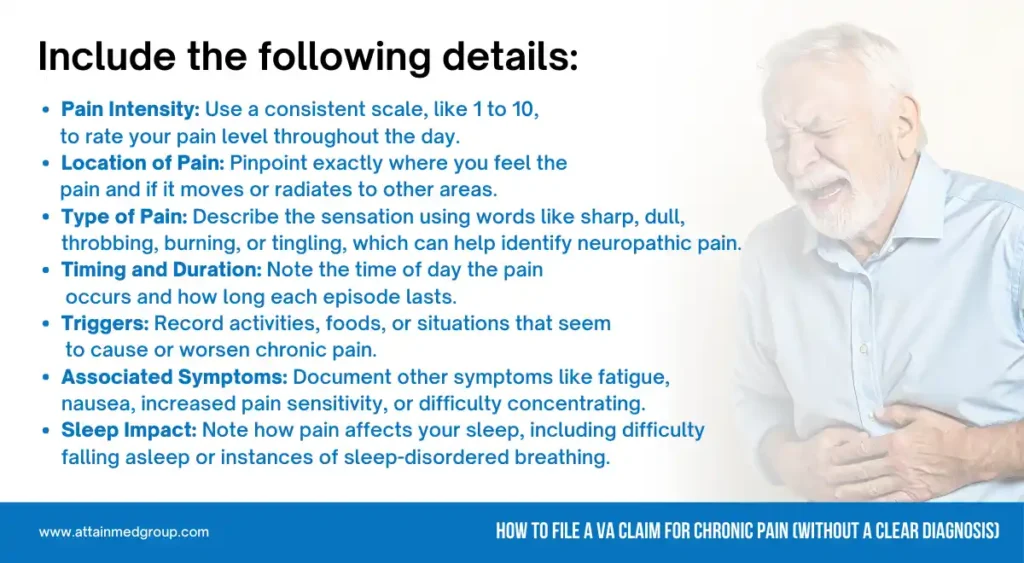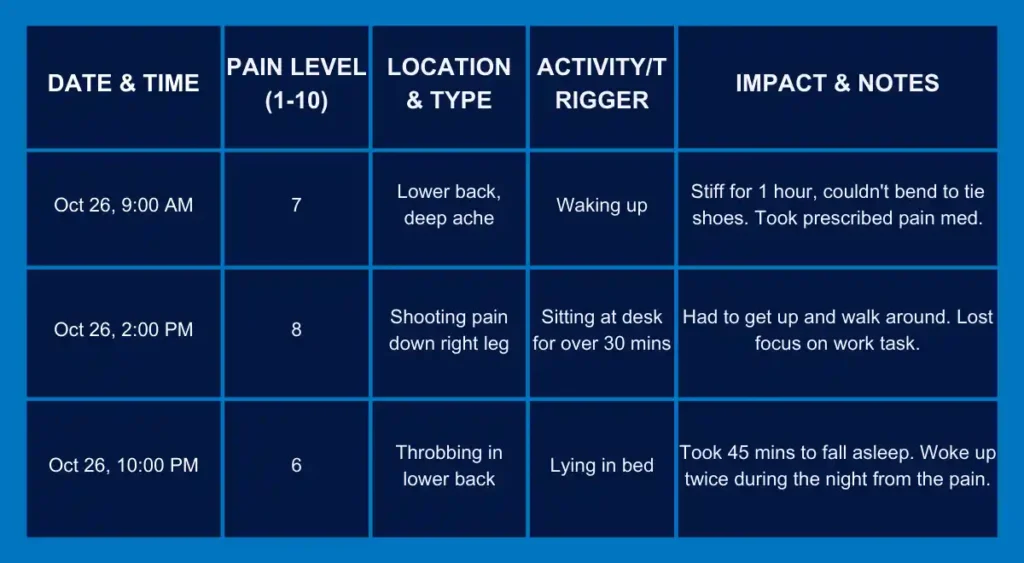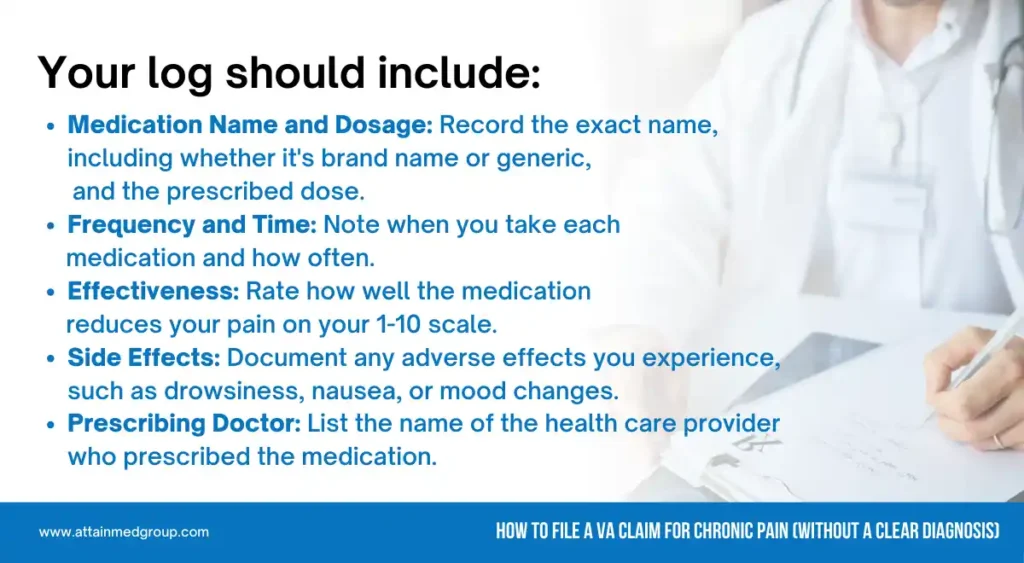Chronic pain can be a frustrating and isolating experience, especially when you are trying to get proper medical documentation. Many people struggle with ongoing pain that lacks a clear diagnosis from their medical care team. Discover how to document Chronic pain conditions medically even when formal diagnoses are unclear or delayed.
This guide will give you actionable strategies for documenting your chronic pain condition. Following these steps helps you communicate your symptoms clearly and build a strong medical record. This documentation is vital for receiving appropriate medical care and for supporting a potential disability claim.
The Foundation: Your Detailed Pain Journal
One of the most powerful tools you have is a detailed pain journal. This log creates a consistent, long-term record of your symptoms and how they affect you. This information is invaluable for your primary care doctor and any specialists you see for pain treatment.
Your journal helps bridge the gap between appointments, showing a pattern that a single office visit might miss. It provides objective data on your subjective experience. A consistent journal can be a critical piece of evidence for a long-term disability claim.

What to Track in Your Journal
Be as specific as possible in every entry. Vague descriptions are less helpful than precise details. Consistently tracking this data helps identify triggers and patterns in your chronic condition.

Documenting these elements provides a complete picture for your health care providers. It transforms your experience into concrete data they can use. This is particularly important for managing chronic noncancer pain where the cause is not always obvious.
Connecting Pain to Daily Life
Your journal should also paint a clear picture of how your symptoms impact your daily activities. This context is essential for demonstrating the severity of your medical condition. Insurance companies reviewing a long-term disability insurance claim need to understand your functional limitations.
Make note of specific examples. Did you have to leave a grocery store because the pain became unbearable? Were you unable to lift a laundry basket or sit through a movie?
These real-life examples illustrate the true burden of your condition. They provide a narrative that raw pain scores cannot convey. This detailed record is a cornerstone of a successful disability claim.
Sample Pain Journal Entry
A structured approach can make journaling easier to maintain. Consider using a table format in a notebook or a dedicated app. This keeps your information organized and easy for your doctors to review.

Building Your Medical File with Objective Evidence
While your journal provides subjective evidence, it must be supported by objective medical records. A consistent history of seeking medical care is crucial. It demonstrates the persistence of your symptoms and your efforts to find a solution.
Every doctor’s visit, test, and treatment contributes to the official record of your chronic condition. These records are the primary evidence reviewed for any disability benefits application. Without them, it is difficult to prove the extent of your health issues.
Consistent Medical Visits
Attend regular appointments with your primary care clinician. Even if a clear diagnosis remains elusive, these visits create a paper trail of your ongoing health problems. Each visit note adds another layer of proof to your medical history.
If you have other chronic conditions, like diabetes mellitus or kidney disease, discuss how your pain interacts with them. This is important, as uncontrolled pain can worsen other health issues. This comprehensive approach to your health care is important for your overall well-being and your documentation.
After each appointment, request copies of the visit notes, lab results, and imaging studies. Keep these organized in a binder or digital file. This ensures you have a complete personal copy of your medical history.
The Role of Specialists
Your primary care provider is your main partner, but sometimes a specialist is necessary. Ask for referrals to experts who can investigate your symptoms further. This might include a neurologist for neuropathic pain, a rheumatologist for inflammatory conditions, or a pain management specialist.
Seeing specialists shows that you are being proactive in your medical care. Their reports can add significant weight to your file, especially if they can identify or rule out specific causes. This can also open the door to different pain treatment approaches, including a multidisciplinary biopsychosocial evaluation or even palliative care for complex cases.
Visual Documentation
If your pain condition causes visible symptoms, document them with clear, dated photographs. This could include swelling, skin discoloration, rashes, or limited range of motion. Visual evidence is a powerful and objective addition to your medical record.
Make sure the photos are well-lit and clearly show the affected area. If possible, use a camera with a date stamp feature or hold a piece of paper with the date in the photo. This authenticates when the photo was taken.
Effective Communication with Your Health Care Team
Open and honest communication with your health care providers is essential. You are an active partner in your own care. Preparing for your appointments helps you make the most of your limited time with the doctor.
Bring your pain journal, medication log, and a list of questions to every visit. Be ready to describe your symptoms thoroughly and provide specific examples of how they affect your life. This helps your clinician understand the full scope of your problem.
Do not downplay your symptoms. Be direct about your pain levels and the limitations they cause. This honest reporting ensures your medical records accurately reflect your condition.

Discussing Treatment Options and Concerns
Engage in a dialogue about your pain control strategy. Ask about different types of pain treatment, from medications to physical therapy. It is also important to discuss any concerns you have about prescribed treatments.
If long-term opioid therapy is suggested, for example, have a frank conversation about the benefits and risks. Discuss potential adverse effects, the risk of physical dependence, and the possibility of opioid-induced hyperalgesia, a condition where opioids can increase pain sensitivity. Your medical team should provide a clear plan for monitoring your opioid pain management.
Understanding all your options helps you make informed decisions about your health. It also shows that you are actively involved in managing your chronic non-cancer pain. This proactive stance is viewed favorably by both medical professionals and disability insurance evaluators.
Tracking All Treatments and Medications
Documenting every treatment you try is just as important as documenting your symptoms. This includes all medications, therapies, and lifestyle changes. A comprehensive log shows you are diligently following medical advice and exploring all available options for your noncancer pain.
This record is critical if you apply for long-term disability benefits. It provides evidence that your condition is persistent and resistant to various treatments. It strengthens your case by demonstrating the severity and stubborn nature of your medical condition.
Maintaining a Medication Log
Keep a separate log specifically for your medications. This helps you and your doctors track effectiveness and manage side effects. An accurate log can prevent dangerous drug interactions and help optimize your pain medication regimen.

Documenting Alternative Therapies
Many people with chronic pain explore treatments beyond conventional medicine. These can include physical therapy, acupuncture, massage, or chiropractic care. It is important to document these efforts as well.
Keep a record of each session, the type of treatment received, and any change in your symptoms. Note both positive and negative outcomes. This comprehensive approach shows you are committed to finding relief and managing your condition responsibly.
Documenting the Full Impact on Your Life
Chronic pain does not exist in a vacuum; it affects every part of your life. Documenting these broader impacts provides crucial context for your medical team and any disability claim reviewers. This includes its effect on your ability to work and your personal relationships.
Work-Related Documentation
If your chronic pain impacts your job, keep meticulous records. This information is vital if you need to request workplace accommodations or file for disability benefits. Your employer’s records can serve as third-party evidence of your limitations.
Track any days of work you miss due to your pain. Keep copies of emails or letters where you request accommodations. Note any changes to your job duties or hours that were made because of your health condition.
Statements from Family and Friends
Those who know you best can provide powerful testimony about how your condition has changed you. Ask trusted friends, family members, or colleagues to write statements describing their observations. These “lay statements” can corroborate your own reports.
These statements should be specific. They can describe changes in your personality, activities you can no longer do, and the overall effect your pain has on your mood and relationships. This third-party perspective adds a layer of credibility to your documentation.

Conclusion
Documenting chronic pain can feel like a significant undertaking, particularly when you are already dealing with the pain itself. However, with these strategies, you can create a comprehensive medical record that accurately shows your experience. This detailed documentation is your best tool for getting the right medical care and supporting a long-term disability claim.
Remember to be persistent in your efforts, thorough in your records, and honest with your healthcare team. By taking an active role in documenting your journey, you empower yourself to manage your pain effectively. Implementing these tips is the first step to successfully document chronic pain conditions medically, even when a formal diagnosis is slow to come.

